Introduction to Hardy Cyclamen
My first encounter with hardy cyclamen was in the garden of the late Rachel Dunham of Cary, NC in the 1960s. I was amazed to see what I thought was a rare perennial, seeding all through her woodland lawn and was immediately struck by how tough cyclamen were, and obviously, how easy they were to cultivate. This started me on a lifetime of cyclamen fondness. My next encounter with the genus was tying to grow the non-hardy Cyclamen persicum hybrids which flooded the box store market starting in the 1970s. It was only after owning my first home that I tried hardy cyclamen for myself, starting in the early 1980s, with the final piece of the puzzle coming together in an expedition to study them in the wild in 2010.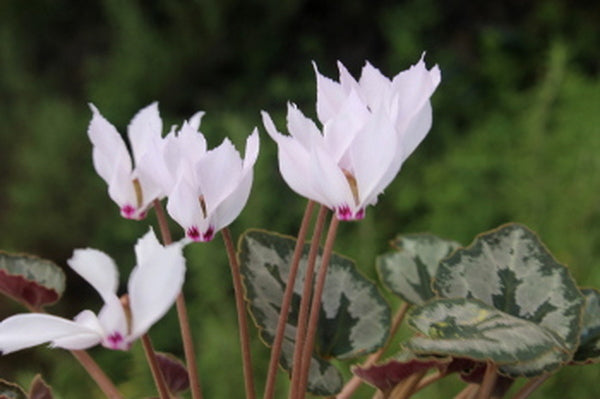
Cyclamen mirabile
Hardy cyclamen are a group of tuberous perennials, whose small stature make them perfect for rock gardens, alpine beds, or potted plants. They have charming pink, white or purple nodding flowers with upright petals that are reminiscent of fairy wings or shuttlecocks. Many cyclamen species bloom in the fall and late winter when there is little else in flower. In addition, cyclamen are prized for their often kaleidoscopic green and silver patterned leaves whose intricacy and variety of form are unmatched in the garden. Once you see a drift of cyclamen in bloom, you too will be enchanted and want to add them to your plant collection.
Here at Plant Delights Nursery and Juniper Level Botanic Garden, we have assembled a wide variety of the world's cyclamen species. Our goal is to research which ones can take our hot humid summers and cold wet winters, then make them available to the public. We invite our readers to stop by the garden on our Open Nursery and Garden Days in order to see our collection and to check out our web site to see our current offerings.
History and Background of Hardy Cyclamen
The name cyclamen comes from the Latin "cyclamnos" which in turn comes from the Greek "kuklaminos" and "kuklos" which means cycle, circle, or wheel. This refers either to the round, wheel-like shape of the tubers or to the fact that the flower stalk circles upon itself as the fruit develops. Cyclamen have several common names, but most people use the genus name as a common name. Other common names include sowbread, Persian or alpine violet. The common name, sowbread, indicates that pigs like to dig and eat the tubers, although Persian violet is misleading because cyclamen are neither violets, nor are they originally from Persia. As with all Latin names, there are arguments as to how to pronounce the name cyclamen. Some people say SY-cla-men and others insist on SIK-la-men. Since Latin is a dead language, whichever you choose to use is fine by us.
Cyclamen species are native primarily to the Mediterranean region: Greece, Italy, Cypress, Crete, Turkey, Lebanon and Israel (where they are the national flower). Some species have radiated from this center of diversity north to Belarus, south to Somalia, west to Libya, Spain and France, and east to Iran.
In the wild, cyclamen grow in rocky terrain or in the leaf litter beneath trees. Although the range of many species do not overlap, I was fortunate in Crete to find both Cyclamen graecum and Cyclamen creticum growing side by side. Cyclamen are well adapted to the Mediterranean climate with its hot dry summers and cool wet winters, but most can be grown in a wide range of temperate climates as long as the summer dormant tubers remain well-drained. Dormant cyclamen are fine with summer irrigation as long as the soil is well-drained and the irrigation isn't excessive.
In their native range, some wild populations of cyclamen have been severely depleted by over collection of tubers for commercial trade, rendering many species endangered in the wild. Although the practice of wild collecting for sale is frowned upon, it is reportedly still common. In a few areas, plant conservation groups have educated people to reduce the harvest down to a sustainable level by substituting seed cultivation for wild collecting. Today, cyclamen are on the Convention on International Trade in Endangered Species (CITES) list of plants that are restricted from import or export. Unfortunately, this poorly executed law also makes it difficult to purchase legally grown plants from nurseries that propagate them from seed. Of course, it is equally difficult to know when you purchase plants, which are truly nursery propagated, as opposed to those which are wild collected and simply "laundered" through plant brokers. Not all species of cyclamen are rare in the wild. When I went to Crete in 2010, I was shocked to find millions of Cyclamen creticum throughout the country.
Although they have been used as ornamentals for the last 400 years or so, cyclamen have been used as medicinal plants for over 2000 years. Cyclamen plants first made their way into European gardens in the 1600s, but for a long time they remained a rare curiosity in specialty collections. In the 1800s the Victorians became enamored with the tender Cyclamen persicum and started breeding it into the multitudinous number of florists cyclamen cultivars that we see today. The Victorians prized cyclamen for their winter flowers and used them as a popular Christmas decoration...a practice that has grown into a huge business today.
Economic and Ethnobotanical Uses of Cyclamen
The Greek doctor and botanist, Dioscorides, documented several medical uses for cyclamen that include its use as a purgative, to speed the delivery of babies, to cause abortions, to make hair re-grow, and as an amorous medicine which caused the person taking it to fall violently in love. The Roman naturalist, Pliny the Elder, described how cyclamen tubers and roots were used to poison fish. Cyclamen tubers are poisonous to people, too, and cause violent diarrhea and even death if eaten raw...note to self...lay off the cyclamen tuber snacking. People in the Near East, however, dry and roast the tubers as a delicacy. The drying/roasting process breaks down the toxins, but if prepared incorrectly, they break down the population growth. Cyclamen flower petals are also used around the world to make tea.
Horticulturally, cyclamen are used primarily as indoor, winter-blooming potted plants and to a lesser extent as garden plants. Potted cyclamen plants have long been symbols of resignation and goodbye, and as such, they are often given to people when they move, change jobs, or retire. As garden plants, they have been used since at least the 1650s, but were not widely popular until after WWII.
Cyclamen Morphology
Cyclamen are tuberous, herbaceous, perennials that grow from either flattened, pancake-like or round tubers...depending on the species. The tuber grows just beneath the soil surface or, in some cases, on top of it. The tubers start out quite small but get wider with age, sometimes exceeding 6" in width and very old tubers can reach the size of a dinner plate. A well-tended cyclamen can live up to 100 years in the same spot. 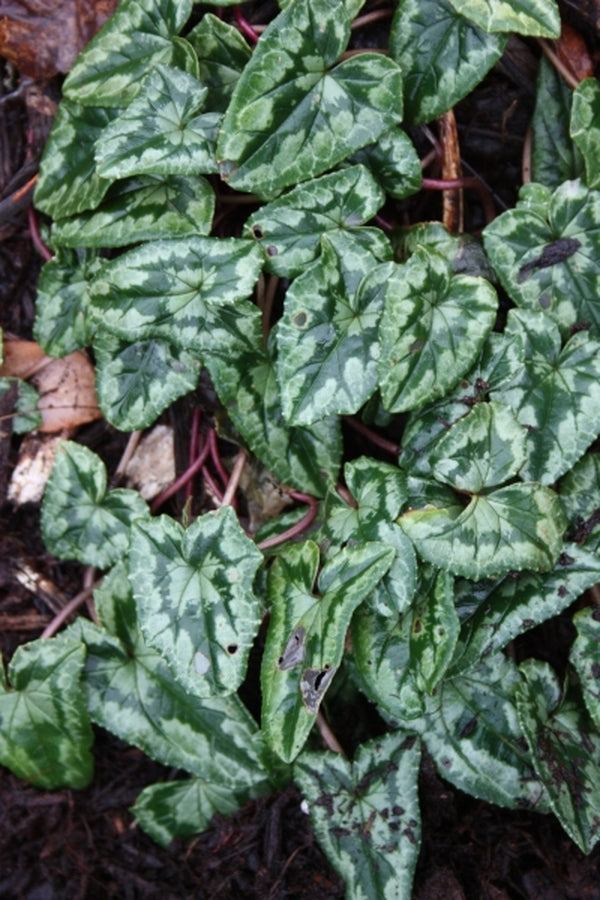
Cyclamen hederifolium 'Silver Arrow'
Cyclamen leaves have a tremendous range of shapes, even within a single species. The leaves may be kidney bean-shaped, heart-shaped, ivy leaf-shaped, or even somewhat triangular. Some are rounded, some are angular, some are short and wide, and others are narrow and elongated. Most species usually have attractive silver variegation patterns on the dark green leaf. The silver variegation appears as blotches, flecks, diamond-shaped patterns, heart-shaped patterns, central "Christmas tree" patterns or "spear head" patterns. Sometimes the entire leaf is colored silver or pewter. On most species, new leaves appear in the fall or winter and rise only 2-4" above the soil. They last until the following summer and then die off while the tuber goes summer dormant.
Like the leaves, the flower stalks rise directly from the tuber. The flower stalks grow up to 5" tall (depending on the species), and curve downward 90 º to 180º (except in Cyclamen alpinum) at the tip (like a candy cane) so that the flower faces downwards. Cyclamen produce a single 4- or 5-petalled flower on each flower stalk. The petals are fused together at the base and form a tube-like structure called a corolla, whose opening faces the ground. The petals are roundish or triangular in shape, and are sometimes twisted around. The point where the corolla splits into the petals may be folded into a small lip called an auricle, which serves as a foothold for the bees that hang upside-down and pollinate the flower. Cyclamen flowers are often compared to those of the ornamental genus dodecatheon because both flowers face downward and have reflexed petals.
Cyclamen flower color varies along a continuum that includes white, various shades of pink, red, and purple. The flowering date varies by species...see the chart below. Some cyclamen bloom in the summer before the new leaves appear, while others flower in the late winter or spring. After the flower is pollinated a curious thing happens. The flower stalk of many species coils up upon itself over and over, like a spring, so that the developing fruit is pulled downward beneath the leaf canopy. This bizarre behavior is beautiful and amazing to observe.
The fruit is a five-chambered capsule about ½" in diameter, containing 5-40 sticky, sugar-coated seeds. When the seeds are ripe, the fruit splits open and ants, attracted by the sugar, carry off the seeds. Nancy Goodwin tells me that she has tasted cyclamen seed and finds them neither sweet nor poisonous...thank goodness for the latter.
Cyclamen Taxonomy
There are 23 species currently recognized in the genus Cyclamen, which is in currently in the family Primulaceae. Its first cousin genera include primula, dodecatheon, and lysimachia. There have been recent suggestions that the genus cyclamen should be moved into the family Myrsinaceae, but that taxonomic battle continues.
Many catalogs and books list virtually each species with a forma album, forma rubrum or variety album or variety rubrum. This is actually incorrect....the words forma and variety are correctly applied to a population that reproduces itself with a set of similar characteristics. These white, pink, etc. flowered forms are simply clonal variants, or when selfed for several generations become a true cultivar seed strain.
Cyclamen coum
Cyclamen Breeding Programs
Since the early 1800s most cyclamen breeding has focused primarily on the florist cyclamen, Cyclamen persicum. Breeding has greatly increased the overall plant size and broadened the flower color and form. Breeders also removed the summer dormancy period of the florist cyclamen, which greatly decreased the production time but made the plant less adaptable to outdoor conditions. Most of the work with florist cyclamens occurred in England, Netherlands, Germany, and Japan. Modern Cyclamen persicum hybrids have many interesting traits including large size, ruffled petals, double flowers, picotee flowers, and a wide range of colors including the breakthrough hues, true red and pale yellow.
The breeding of other cyclamen species pales in comparison to Cyclamen persicum. There are many nurseries and collectors who make hand crosses and evaluate seedlings, but there are few inbred breeding lines and breakthroughs in size, form, or flower color. Only a handful of interspecies crosses have ever succeeded. Modern breeders have started using techniques such as colchicine-induced polyploidy and embryo rescue to make crosses that were previously impossible. Breeders are focusing on creating hybrids of cold-tolerant and cold-sensitive species to create winter-hardy hybrids that have the traits of the frost sensitive species.
Prominent cyclamen growers of recent time include Nancy Goodwin of Montrose Garden in Hillsborough, NC, Robin Hansen of Hansen Nursery in Oregon, Ellen Hornig of the former Seneca Hill Perennials in New York, the late Peter Moore of Tile Barn Nursery and John Massey of Ashwood Nurseries, both in England. Please forgive us if we missed others. These folks all help conserve the wild species by making them available to the public from cultivated stock, but they also select plants with novel leaf variegation and flower traits.
How to Grow Cyclamen in the Garden
Hardy Cyclamen are small plants which like to be planted under trees and shrubs. Cyclamen are easily covered up and out-competed by spreading perennials, so their best companions are small clumping plants such as anemone, buttercup (ranunculus), chionodoxa, crocus, scilla, galanthus, eranthis, primula, and small ferns and hostas. Reseeding perennials like helleborus can eventually smother small cyclamen.
Although Cyclamen coum and Cyclamen hederifolium are the most commonly grown garden species, many others also make worthy, easy-to-grow garden plants. According to Nancy Goodwin, gardeners who grow a wide array of species can have a succession of flowers in every month of the year. The following bloom calendar of selected species is based on our observations here in Raleigh, North Carolina, USA (Hardiness zone 7b, 35ºN latitude). Also included on the list are the reputed blooming seasons of some other species.
| Cyclamen Bloom Calendar | Jan | Feb | Mar | Apr | May | Jun | Jul | Aug | Sep | Oct | Nov | Dec |
|---|---|---|---|---|---|---|---|---|---|---|---|---|
| Cyclamen alpinum | X | X | X | |||||||||
| Cyclamen balearicum | X | X | X | |||||||||
| Cyclamen cilicium | X | X | X | X | X | |||||||
| Cyclamen colchicum | X | X | X | X | ||||||||
| Cyclamen creticum | X | X | X | |||||||||
| Cyclamen coum | X | X | X | X | ||||||||
| Cyclamen cyprium | X | X | ||||||||||
| Cyclamen graecum | X | X | X | |||||||||
| Cyclamen hederifolium | X | X | X | X | X | |||||||
| Cyclamen intaminatum | X | X | X | X | ||||||||
| Cyclamen libanoticum | X | X | X | |||||||||
| Cyclamen mirabile | X | X | X | X | ||||||||
| Cyclamen pseudibericum | X | X | X | |||||||||
| Cyclamen purpurascens | X | X | X | X | ||||||||
| Cyclamen repandum | X | X | X | |||||||||
| Cyclamen rhodium ssp peloponnesiacum | X | X | X | |||||||||
| Cyclamen rohlfsianum | X | X | X |
To grow cyclamen successfully, it is important to understand their needs. Cyclamen are primarily native to the Mediterranean, which has a climate of hot dry summers and cool wet winters with few frosts. Plants native to the Mediterranean have adapted by actively growing in the winter and going dormant in the summer. Cyclamen are thus sensitive to excessive summer moisture because they do not consume much water when they are dormant. As a result, summer rains and excessively run irrigation systems, combined with poor drainage, can easily rot the tubers. While wild cyclamen will take some direct sun, they usually grow in the understory of trees and shrubs and in rocky crevices, competing successfully with tree roots for water. They are not tolerant of windy sites as they are adapted to the protective shelter of trees, shrubs, and large rocks. Some species prefer dappled shade (Cyclamen balearicum, C. creticum, C. intaminatum, C. mirabile, C. parviflorum, C. purpurascens, C. repandum, C. alpinum) while others prefer a more open site, even with a couple of hours of sun (Cyclamen coum, C. cilicium, C. graecum, C. hederifolium, C. libanoticum, C. pseudibericum).
Cyclamen can tolerate many soil types and a wide range of pH, although they prefer a slightly alkaline, well-drained soil. Soil pH below 5.5 should be avoided. All species appreciate having PermaTill® or pea gravel incorporated into the soil if drainage is a concern, and the woodland species (Cyclamen purpurascens, Cyclamen repandum, Cyclamen creticum) enjoy a soil amended with leaf compost and composted bark.
Cyclamen hederifolium and Cyclamen graecum tubers should be planted with the top of the tuber just below, the soil surface, although slightly deeper is also fine. Nancy Goodwin tells me that she finds the spring-flowering species prefer to be planted slightly deeper since it helps keep them from sprouting too early in spring. In the wild, I found most tubers of Cyclamen graecum and Cyclamen creticum at a depth of 3-9". The less hardy species are certainly better if planted 3-6" deep for protection from cold winter air. Some species even have contractile roots that will pull the tuber down to the appropriate depth. Be sure to mark the location of your tubers so that you don't damage them while they are dormant. 
Cyclamen hederifolium 'Silver Tongued Devil'
The following list groups the species from easiest to grow in temperate gardens to most difficult, based on their cold hardiness and overall adaptability.
1. Cyclamen hederifolium, cilicium, coum, and alpinum
2. Cyclamen purpurascens, pseudibericum, repandum, mirabile, rhodium, intaminatum, graecum, colchicum
3. Cyclamen balearicum, creticum, and parviflorum
4. Cyclamen africanum, Cyclamen coum ssp. elegans, Cyclamen rhodium ssp. peloponnesiacum, persicum, rohlfsianum, and somalense
Cyclamen are also grown in containers by plant collectors. This is a great way to show off the leaves and flowers, and in the UK, potted plants are frequent award winners in floral shows. If you've ever tried to keep a florist cyclamen hybrid alive, you will know that this isn't an easy task…especially for lazy gardeners. That being said, in the nursery we find the hardy cyclamen quite easy to grow in pots. Cyclamen prefer a high quality, well-drained potting soil, and a near perfect watering regimen. The tubers do not like to freeze and thaw repeatedly in the winter, so locate your pots so that extreme winter temperatures are moderated. A cold frame or similar structure works perfectly for overwintering the pots. Repotting should be done during the summer dormant period, although cyclamen prefer to be somewhat potbound.
In containers, a yearly application of a good slow release fertilizer is recommended, just before the foliage begins to grow. In the ground, no fertilizer should be needed if the soil is properly tested and amended organically at the time of planting.
Garden cyclamen are relatively free from pests and diseases. Various insects such as aphids, weevils and thrips will nibble on them from time to time, but if the plants are grown stress free, pest problems will be virtually non-existent. Container grown plants can have aphid problems when the new growth emerges.
How to Propagate Cyclamen
Reportedly, cyclamen tubers may be divided like potatoes during their dormant period. Each cut section must contain at least one growing point (eye) on the top and one root bud (initial) on the bottom. The cut tubers should be dried for a few days and dusted with fungicide prior to planting. The tubers desiccate quickly, so division can be tricky. We have not personally tried this technique. As of 2009 there had only been one successful case of cyclamen being cloned by tissue culture, which occurred at Terra Nova Nurseries who produced a cultivar, Cyclamen coum 'Something Magic'. However, in 2010 a tissue culture protocol was developed that worked for several Cyclamen species and was published by a Dr. Anika Prange and team in Germany.
The best way to propagate garden cyclamen is to collect and sow seeds. Cyclamen are facultative out-crossers so they will set seed best if there are multiple plants growing near each other (that are not clones). Keep an eye on the developing fruits. They will start to soften prior to splitting open. You need to collect the seed after they are mature, but before the fruit opens since insects will likely haul them away before you do. Ripe seed change color from white to light brown. When they dry out, they turn dark brown.
Since the seed have no dormancy requirements, they are best sown fresh and will germinate in 2-4 weeks. They can also be dried and stored for a year or so if needed. Seed sown after the parent plants go dormant can wait until the typical growing season begins before sprouting. The longer the seed have been stored, the more erratic the germination will be. Since light inhibits germination, sow seed ¼" deep in a pot with good potting soil such as Fafard. Keep the pot slightly moist but not water-logged, allowing the surface to just become dry between waterings. If the mix dries too much, the seedlings will die. Ideal seed germinating temperatures should be based on the temperature in their native habitat when the plants sprout. In other words, plants which emerge from dormancy in summer germinate at a much higher temperature than species that emerge from dormancy in winter. The germinating seeds will first form a small tuber, followed by a single leaf. I prefer to transplant them to individual cell pack flats at this time. With good care, your cyclamen should start to flower in about 18 months, at which point they can be planted into the garden.
List of Cyclamen Species and Hybrids
Cyclamen africanum grows in scrub and rocky gullies in northern Algeria and Tunisia. It is very closely related to Cyclamen hederifolium, and will interbreed with it. There are diploid (2n=34) and tetraploid (2n=68) forms, both vigorous plants with large coarse, bright green, leathery leaves. Leaf patterns are generally less distinct than in many other species although "silver" leafed forms exist. The leaves are often very large, frequently exceeding 4" in diameter. Flowers vary from pale pink to a deep rose-pink. The Cyclamen africanum that we grow is marginally hardy in our Zone 7b garden, but our C. africanum accessions could possibly be hybrids with C. hederifolium, which would explain their unexpected hardiness. (Hardiness Zone 8-9)
Cyclamen alpinum (a.k.a. Cyclamen trochopteranthum) is native to southwest Turkey up to 4,600' elevation. The most unique feature is the propeller-like appearance of the flowers which is caused by the petals being only reflexed 90º (rather than the usual 180º) and then slightly twisted. The honey-scented flowers top the small plant from mid-August through December. The leaves are deep green with grey-green or cream colored marbling. (Hardiness Zone 7-9, at least)
Cyclamen balearicum comes from the mountains of the Mediterranean islands of Mallorca, Minorca, Ibiza and Cabrera (the Balearic Islands). Cyclamen balearicum is closely related to Cyclamen creticum and Cyclamen repandum and will hybridize with the latter. It is a small species with grey-green leaves, often with a silver sheen and a crimson underside. The sweetly scented flowers with twisted petals are white, but often with a veining of pale pink or white...similar to Cyclamen intaminatum. Most are subtropical, but we are growing a cold-tolerant selection here at Juniper Level Botanic Gardens. (Hardiness Zone 8-9, at least) 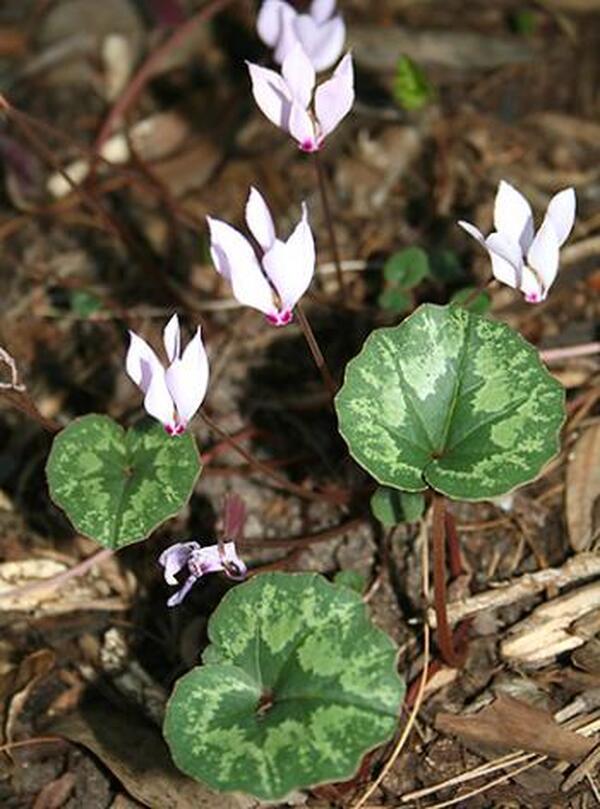
Cyclamen cilicium
Cyclamen cilicium is a native of Turkey that prefers more sun and better drainage than other species. The round leaves are usually green and silver-mottled. The honey-scented flowers range in color from deep pink to white. In NC, Cyclamen cilicium flowers from early October through December...just preceding Cyclamen coum. Our clumps have thrived for more than a decade under a large eucalyptus tree...very dry in the summer. (Hardiness Zone 5-8 at least)
Cyclamen colchicum is native to the Caucasus mountains, but is rare in cultivation. It has thick, leathery, heart-shaped leaves with finely toothed edges and a narrow silver pattern. The flowers are carmine pink, fragrant, and the petals are slightly twisted. We do not grow this species here at Juniper Level Botanic Garden. (Hardiness Zone 5-7, possibly colder)
Cyclamen coum are exquisite little gems that burst forth in late fall with small, rounded, quarter-sized leaves of black-green...occasionally patterned with dramatic silver markings. The foliage is topped in late winter (December - March in NC) by 2" tall stalks, topped with flowers that range from pink to purple. Cyclamen coum was named by the Royal Horticultural Society as one of the top 200 plants of the last 200 years. This species is native in open conditions in Bulgaria, Turkey, Israel, Syria, and Lebanon, through Georgia and the Crimea to northern Iran. (Hardiness Zone 4-8)
Cyclamen coum 'Maurice Dryden'
Cyclamen coum 'Blush' has silver leaves, topped with spikes of soft pink flowers with rounded petals.
Cyclamen coum 'Maurice Dryden' has a strong silver leaf form, topped with stalks of white flowers with magenta blotch at the base.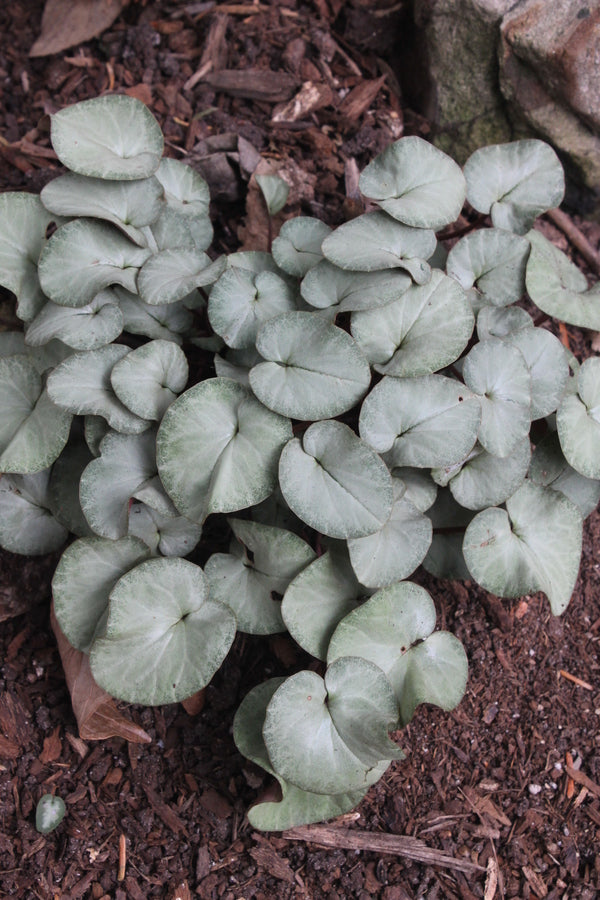
Cyclamen coum Pewter Leaf Form
Cyclamen coum 'Pewter Leaf' has quarter-sized pewter leaves, highlighted by a dramatic black-green border. The small clumps are adorned in late winter (January, February in NC) by 2" tall spikes of flowers, ranging from pink to purple.
Cyclamen coum 'Rubrum' is a commercially produced seed strain with bright carmine-pink flowers, although the Latinized name is nomenclaturally invalid.
Cyclamen coum 'Tilebarn Elizabeth' from Tilebarn Nursery has solid green leaves and magenta flowers that fade in the center to white.
Cyclamen coum Silver Leaf is a seed strain with small, rounded, quarter-sized silver leaves highlighted by a dramatic black green border. The small clumps are adorned in late winter (January, February in NC), by the 2" tall spikes of flowers ranging from pink to purple. 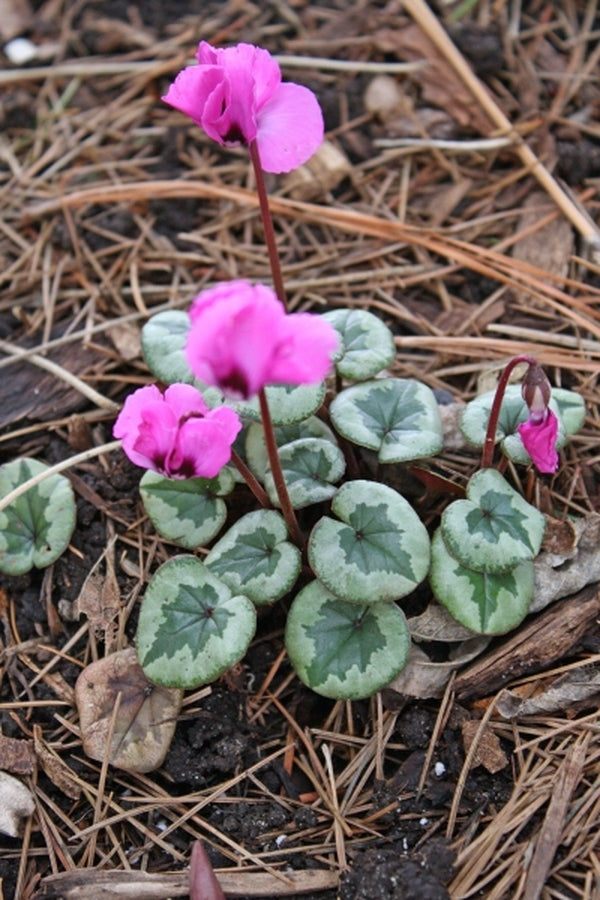
Cyclamen coum 'Something Magic' PP19,894
Cyclamen coum 'Something Magic' is the first cloned selection to be successful in tissue culture (Terra Nova Nurseries) after several hundred attempts. The small, dark green, rounded leaves are highlighted by a pewter center. The clumps, which sprout from a thick corm, are topped with short violet-pink flowers in late winter.
Cyclamen coum ssp. caucasicum hails from the Caucasus and is similar to the species except the leaf may be slightly scalloped.
Cyclamen creticum is native to Crete and Karpathos, but rare in cultivation. The leaves appear in late autumn and the pure white, faintly scented flowers appear in April and May. Leaves are dark green with either a silver wash or silver specks. This is a woodland plant, closely related to C. repandum and C. balearicum that likes dappled shade. This is reportedly not a cold hardy plant, but we found these growing above the tree line at over 3,000' elevation in Crete, so there is most certainly far more hardiness potential than has been realized. Nancy Goodwin says that late spring frosts pose a problem for both C. creticum and related species in our climate. Cyclamen creticum likes more shade than most species and prefers growing in damp conditions with leaf debris and compost. (Hardiness Zone 7b-9) 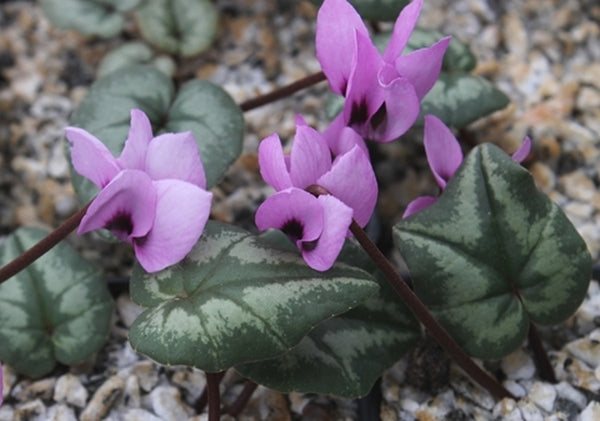
Cyclamen elegans
Cyclamen cyprium is found only on the island of Cyprus. The very strongly scented, small, graceful, white flowers have narrow petals and a magenta blotch at the base of the petals. Small olive-green leaves with light green markings appear with the flowers in autumn. (Hardiness Zone 8-10, guessing)
Cyclamen elegans is native to Iran but rare in the commercial trade. We do not currently grow this species here at Juniper Level Botanic Gardens. It has heart-shaped leaves with a narrow silver spear-shaped pattern. The flowers are larger than other species and are pink with a dark purple mark at the base of the petals. The petals are long and pointed at the tip. (Hardiness Zone 9-10, guessing) 
Cyclamen graecum
Cyclamen graecum is a rarely grown cyclamen species that is one of our favorites. It's a bit more difficult than C. hederifolium, so don't make this species your first attempt with hardy cyclamen. While not as vigorous as Cyclamen hederifolium, the very dark green, velvety-appearing foliage (often patterned silver) is stunning even when not in flower. The leaves include some of the most striking patterns and vivid color combinations found in the entire genus. In late summer and fall, the tiny clumps are topped with flowers of red, pink, rose, or white...rising just above the foliage. Cyclamen graecum prefers a more sunny site than most of the other cyclamen species. This is a variable species with a wild distribution in Greece, Crete, Turkey, and Cyprus on screes and other rocky sites. (Hardiness Zone 7-9)
Cyclamen graecum ssp. graecum 'Glyfada'
Cyclamen graecum var. anatolicum has smaller flowers than the species but are sweetly scented.
Cyclamen graecum 'Glyfada', discovered by Brian Mathew at Glyfada near Athens, has a completely silver leaf with no hastate pattern, topped by stalks of pale magenta flowers.
Cyclamen graecum 'Rhodopou' is a pewter-leaf strain from plants which grow on the Rhodopou peninsula in Crete.
Cyclamen graecum ssp. candicum originates from the Lefka Ori region of Crete. Flowers are white to pale pink, usually with a deep purple basal blotch.
Cyclamen hederifolium 'Album'
Cyclamen hederifolium has striking green and silver mottled, ivy-shaped foliage that emerges in early October, making 6-24" wide mounds. The leaves often emerge from the ground as much as 1' away from the tubers, attached by a long underground leaf petiole. Starting in July most years, and continuing through fall, the tiny pink flowers poke through the ground months prior to the emerging foliage. Cyclamen hederifolium are great in mass and will naturalize in woodland settings. Cyclamen hederifolium was named by the Royal Horticultural Society as one of the top 200 plants of the last 200 years. This species has a wide distribution from France to Turkey. (Hardiness Zone 4-8)
Cyclamen hederifolium 'Album' are selected white-flowered forms.
Cyclamen hederifolium 'Bowles's Apollo' has a pewter colored leaf with a green arrow in the center and a silver shield inside. 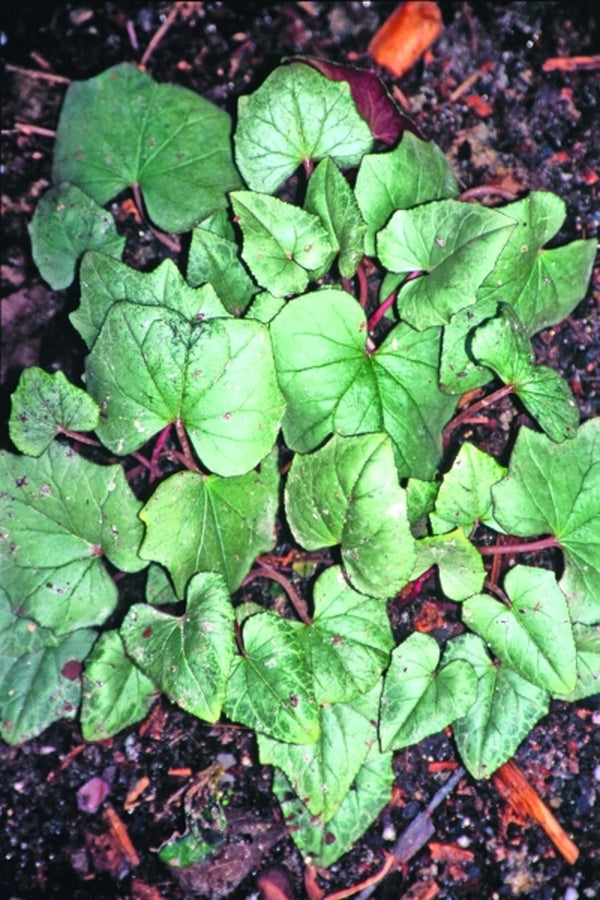
Cyclamen hederifolium 'Nettleton Silver'
Cyclamen hederifolium 'Nettleton Silver' is a seed strain developed by the UK's Alan Martin that is composed of mostly silver leaves that emerge after the white flowers finish in fall.
Cyclamen hederifolium 'Pearlentippich' has white flowers.
Cyclamen hederifolium 'Pewter White' has white flowers and pewter leaves.
Cyclamen hederifolium 'Silver Arrow'
Cyclamen hederifolium 'Rosentippich' has rose colored flowers.
Cyclamen hederifolium 'Silver Arrow' has gorgeous leaves are edged with green, and moving inward have successive silver and green sections. The center of the leaf has an ivy-leaf shaped silver marking. The flowers are light pink.
Cyclamen hederifolium 'Silver Cloud' is an introduction from UK cyclamen specialist Phil Cornish, who bred these from the "Apollo" group of Cyclamen hederifolium. For us, these have been stunning with their solid pewter silver leaves from fall into spring. In fall, the plants are topped with complementary spikes of bright pink flowers.
Cyclamen hederifolium var. confusum has leaves that are shorter and wider than the species. They are also shiny and may or may not have patterning.
Cyclamen hederifolium 'White Cloud' has white flowers and silver leaves shaped like arrows.
Cyclamen intaminatum is a diminutive plant native to Turkey. The flowers, which are white with grey veins or pale pink, appear in autumn, emerging either before or along with the leaves. The leaves are almost round and are either plain green or have a grey marbling in the center. Cyclamen intaminatum is fairly hardy, but due to its small stature is usually grown in pots or in an alpine garden. (Hardiness Zone 5-8, at least)
Cyclamen libanoticum is native to Lebanon and has large flowers which appear in early spring. The flowers open white and turn pale rose pink, particularly towards the tips of the petals. There is a small crimson-magenta blotch at the base of each petal. The leaves are greyish-green, usually with a grey marbled pattern. Although cold hardy, it does not like both low temperatures and wet conditions, and the flowers are often damaged by freezing temperatures. Plant it amongst tree roots or against the base of a wall for best results. (Hardiness Zone 7-10)
Cyclamen mirabile 'Tilebarn Anne'
Cyclamen mirabile is a group of little tubers that we love, not only for the charming pink flowers produced in fall, but also for the highly ornamental silver dollar-sized foliage which is often intricately patterned in silver and green. The 1" very pink flowers nod, as is typical of the genus, and the individual petals are often twisted. New foliage emerges in autumn and is sometimes flushed pink. This species is native to Turkey on rocky hill slopes. (Hardiness zone 6-8 at least)
Cyclamen mirabile 'Tilebarn Anne' is an overall silver leafed form with pink flowers. The leaf veins are quite marked and impart a striking character to the bright silver leaves, which usually have a strong pink hue when they first appear.
Cyclamen mirabile 'Tilebarn Jan' is a white flowered form of Cyclamen mirabile sometimes with a pink blush to the nose of the flower.
Cyclamen mirabile 'Tilebarn Nicholas'has a leaf with a Christmas tree shape in the center, surrounded by a wide pink/silver band.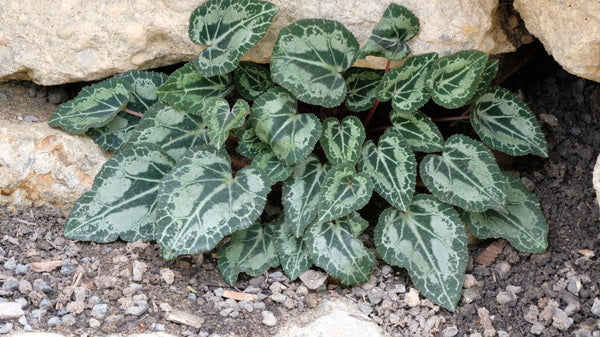
Cyclamen persicum 'Turkish Delights'
Cyclamen parviflorum is a very small alpine plant from northeast Turkey that we do not currently grow here at Juniper Level Botanic Garden. It is difficult to grow and is the smallest known cyclamen. It has small green heart-shaped leaves and pink or purple flowers. It is quite cold hardy but cannot tolerate heat. (Hardiness Zone 5-7a, guessing)
Cyclamen persicum (Florist's Cyclamen) grows wild in Turkey, Syria, Lebanon, Israel, Jordan, the Greek Algeria and Tunisia, but not in Persia as the name implies. Cyclamen persicum is the parent species of the florist's cyclamen but the cultivated varieties no longer resemble the wild types. The flowers are generally fragrant, white or soft pink with a deep pink or crimson-magenta zone at the base of each petal and appear in late winter through spring. The leaves are green, often with marbling on the upper surface. Cyclamen persicum is principally a tender plant which will not tolerate frost, but there are some potentially cold-tolerant taxa from high altitude populations that we are trialing here at Juniper Level Botanic Garden. Although there are a small number of inter-specific hybrids, the common usage of the term "cyclamen Hybrids" or "Florist's Cultivars" refers to intra-specific hybrids of Cyclamen persicum origin. (Hardiness Zone 9b, guessing)
Cyclamen persicum f. puniceum Lebanon form has flowers that are usually darker pink than plants from other locations. Cyclamen pseudibericum is a choice late winter and early spring flowering species that flowers alongside Cyclamen coum. The clumps are composed of toothed heart shaped dark green leaves (purple underneath), often highlighted with dramatic silver patterns. The flattened clumps of foliage on this Turkish native are topped with dense clusters of light to dark pink, shooting star-like, large, fragrant flowers. (Hardiness Zone 7-8)
Cyclamen pseudibericum f. roseum is a 1966 introduction that was collected at Dortyol in Turkey. The flowers are a beautiful rose pink. 
Cyclamen purpurascens
Cyclamen purpurascens is a Mediterranean species that we have had good luck with, provided it is planted where it can stay fairly dry in the summer months. In the wild, it is found on alkaline soils throughout much of Europe, hailing from as high as 4,200 feet elevation...further north than any other cyclamen species. The round patterned leaves and dark pink fragrant flowers spring alive in June and continue into August, adding great color to the summer woodland garden. In colder climates, great drainage in the winter is key to good survival. This species does not go dormant and retains its leaves throughout the year. The seeds are slow to germinate. (Hardiness zone 5-7 probably colder)
Cyclamen repandum, which is native to Italy, Corsica, and Algeria, is considered by some gardeners to be the loveliest of the hardy cyclamen species. The leaves are ivy-shaped with a slightly dentate edge and a variety of silver patterns. The sweetly-scented flowers, often with twisted petals, are pink to purple and are produced in profusion. Cyclamen repandum is considered to be difficult to grow because it does not tolerate being too wet or too dry and does not tolerate too much exposure to wind. We do not currently grow this species here at Juniper Level Botanic Garden, but according to plantswoman Nancy Goodwin, this and its relatives are best when planted 2-3" deep. (Hardiness Zone 7-9, guessing)
Cyclamen rhodium (syn: C. repandum ssp. rhodense) is the result of tremendous taxonomic confusion. It has been lumped in with Cyclamen repandum, but is much more closely allied, however, to C. balearicum and has performed very well for us in the garden. (Hardiness Zone 6-9, guessing)
Cyclamen rhodium ssp. peloponnesiacum (syn. Cyclamen repandum ssp. peloponnesiacum, Cyclamen peloponnesiacum) is native to the Peloponnese area in the south of Greece. It is particularly valued for the attractive leaf markings which are spotted and splashed with silvery-white. It has pale pink flowers bearing a deeper pink nose. (Hardiness Zone 6-9, guessing)
Cyclamen rohlfsianum is a rare, difficult to cultivate species that grows only on the foothills in Libya. It is reportedly not frost-tolerant but we are trialing it here at Juniper Level Botanic Garden. It has pink, sweetly fragrant flowers in the autumn. The leaves, whose lower surface is either purplish or red, appear in late summer, and are unique in the genus. They are dark green with light green or silver patterns with an ivy geranium or maple-like shape. Cyclamen rohlfsianum is the only species that always has flowers with protruding anthers like Dodecatheon. Keep this one very dry. (Hardiness Zone 9-10, guessing)
Cyclamen somalense is a recently discovered Somalian species that we do not currently grow here at Juniper Level Botanic Garden. The leaves are rather fleshy, deep dull green with a marked silvery pattern in the middle above, with purple beneath. The flowers, which appear with the leaves, are pale pink suffused with carmine around the mouth and held just atop the foliage. (Hardiness Zone 9-10, guessing)
List of Cyclamen Hybrids
Cyclamen do not hybridize in the wild. In cultivation, they cross only with some difficulty because most species have different chromosome numbers. There are only 7 registered hybrids with 4 or 5 more putative crosses that have not yet been registered. Their traits are usually intermediate between the parents unless otherwise noted. 
Cyclamen x hildebrandii
Cyclamen x drydeniae (Cyclamen coum x Cyclamen alpinum). The offspring generally have twisted petals and are fertile. (Hardiness Zone 5-8, at least)
Cyclamen x hildebrandii(Cyclamen africanum x Cyclamen hederifolium) is the first registered hybrid, created in 1955. The resulting plants resemble C. hederifolium on steroids, with a more muted leaf pattern. (Hardiness Zone 7-8, at least)
Cyclamen x meiklei (Cyclamen creticum x Cyclamen repandum) (Hardiness Zone 7b-9, guessing)
Cyclamen x saundersiae (Cyclamen balearicum x Cyclamen rhodium ssp. peloponnesiacum) has variable silver spotted and marbled leaves, and usually pink flowers. (Hardiness Zone 7-9, guessing)
Cyclamen x schwarzii (Cyclamen libanoticum x Cyclamen pseudibericum) (Hardiness Zone 7-9, guessing)
Cyclamen x wellensiekii (Cyclamen cyprium x Cyclamen libanoticum) is named after Professor Dr Ir. S.J. Wellensiek of the Agricultural University of Wageningen, Netherlands, who first produced the hybrid in 1969. It flowers over a long period during winter and sets fertile seed. The flowering period is greatly extended and lasts as long as 6 months. (Hardiness Zone 7b-9, guessing)
Cyclamen x whiteae (Cyclamen graecum x Cyclamen hederifolium) The flowers of this cross are unusually stubby. (Hardiness Zone 6-8, at least)
Conclusion
Hardy cyclamen are truly great garden plants and with a diverse collection so you can enjoy their flowers year round. Even without flowers, the intricately patterned leaves are stunning...sort of like snowflakes...no two are the same. Under the correct growing conditions, there are few easier to maintain plants in the garden...we hope you will enjoy trying cyclamens in your own garden. A special thanks to Nancy Goodwin of Montrose for her very helpful review and comments.
Additional Resources
References
The Cyclamen Society, www.cyclamen.org
Druse, K. & Roach, M., (2004), The Collector's Garden, Timber Press, Portland Oregon, Pg. 65
Grey-Wilson, C., (2002), Cyclamen: A Guide for Gardeners, Horticulturists and Botanists, Timber Press, Portland Oregon
Loewer, P. (1988), Success with Cyclamens, Horticulture Magazine, February issue. Pp. 50-55
Prangea, A., et. al., Regeneration of different Cyclamen species via somatic embryogenesis from callus, suspension cultures and protoplasts, Scientia Horticulturae, Vol 125, Iss 3, Pg 28 June 2010, Pages 442-450

